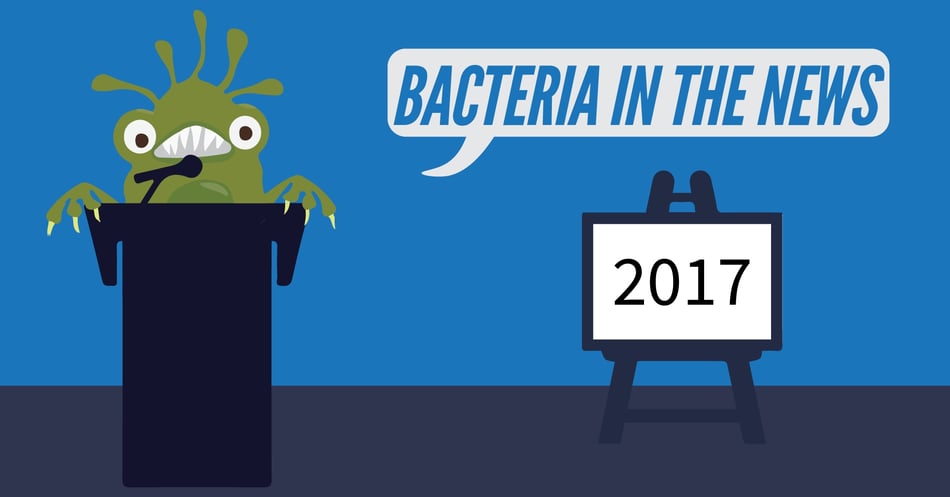2017 Bacteria In the News

2017 proved to be a big year for bacteria in the news, and not just in healthcare! Supported by advances in genomic sequencing and other technologies, research into bacteria has arisen in fields as varied as anthropology, climatology, and even aeronautics. Let's take a look at the biggest stories featuring bacteria from this past year.
-
CANCER RESEARCH
Bacteria could one day treat some cancer tumors. Promising research shows that one day, certain strains of bacteria could be injected into solid tumors to help destroy cancer cells as well as spur the patient's immune system into action. Meanwhile, scientists working in immunotherapy cancer treatments have discovered that a patient's response to treatment may be affected by the bacteria making up his or her gut microbiome. While still preliminary, these two areas of study indicate that bacteria will play an important role in cancer research in years to come. -
ANTHROPOLOGY
Scientist have discovered a way to extract DNA from the dental plaque on tooth fossils belonging to Neanderthals. Much of this DNA belonged to the bacteria that once colonized the individuals' mouths, just as bacteria lives in all our mouths today. By sequencing a whole genome of this bacteria, researchers were able to demonstrate that it was closely related to our modern-day mouth bacteria. Since mouth bacteria can only be transmitted via saliva, this connection might indicate that our ancestors and Neanderthals either shared food - or kissed. Either way, it's a pretty remarkable theory! Another interesting discovery was that the Neanderthals that ate a diet heavy in meat had a much different mouth microbiome than those who survived on a mostly vegetarian diet. Samples from the fossils of a Neanderthal who had a dental abscess contained residue from a plant with known analgesic (pain-fighting) properties, perhaps indicating that Neanderthals used plants as medicines. -
HYGIENE
The growing trend of backyard chickens resulted in an uptick in Salmonella infections this year - over 1000 cases, with more than 200 hospitalizations. The reason? Snuggling. All the outbreaks were traced back to individuals who not only kept chickens at their home, but also allowed them to live inside the house and had petted and snuggled with their chickens as pets. Unfortunately, over a third of the cases were children, who are especially vulnerable due to immature immune systems and less knowledge about hygiene. It is therefore imperative that the adults who tend backyard chickens set and uphold strict rules about contact with the chickens, since even healthy chickens can transmit Salmonella - and worse, avian flu. -
EPIDEMIOLOGY
Even as the Zika outbreak is dying down in the US, scientists are testing a novel treatment that targets not humans, but rather the mosquitoes that carry the Zika virus. Thousands of mosquitoes were infected with Wolbachia bacteria, a naturally occurring microorganism that is found on many insects, but not mosquitoes. When manually infected with the bacteria, however, the female mosquitoes' eggs will not hatch, reducing the mosquito population in a specific area. -
MECHANICAL ENGINEERING
A group of engineers has answered a question that has perplexed researchers for a long time: How do raindrops launch bacteria into the air? We've known that it does happen - the airborne bacteria are what cause the earthy smell after a rainstorm - but had no idea how until a research group was able to capture the action with high-speed cameras and fluorescent dye. The result? Bubbles. The raindrop traps tiny bubbles of air when it strikes the ground, and those tiny bubbles burst, spraying water, and any bacteria in that water, into the air. The best way to understand is to see what they saw in their videos. -
GENETICS
All life, from 100-ft tall Sequoias to microscopic bacteria, is based on DNA. This organic molecule is constructed from an endless recombination of just 4 nucleobases, the A, T, C, and G that make up our genomic code. This year, a group of scientists were able to successfully add two new synthetic bases to the mix, producing a living and successfully reproducing strain of semi-synthetic E. coli bacteria. The result of these new bases is the organism's ability to create new, never-before seen proteins. The potential areas of discovery include possible new medicines, and likely so much more. -
CLIMATOLOGY
Bacteria are found throughout the sky, with live samples recovered from as high as the stratosphere, 9 miles above the surface of the Earth. New research seems to indicate that not only can bacteria lead to precipitation, by increasing the freezing temperature of water, they may also influence lightening. Bacteria truly are everywhere. -
SPACE SCIENCE
Bacteria may catch a ride on gusts of wind that reach the stratosphere, but they must rely on man-made technology to reach space. And they haven't just reached space, they've colonized it. And not just the spaces where humans live! This year, Russian cosmonauts reported finding living bacteria on the outside of the International Space Station. Bacteria is nothing new to the ISS - bacteria hitch a ride despite every precaution to remain sterile - but this finding might indicate that bacteria have even found a way to survive in almost any environment.
As new technologies advance, our insights into the influence of bacteria in our survival is sure to advance as well. Since bacteria are found literally everywhere, it is not surprising to learn that they play a role in almost every aspect of our lives. As we learn more about these one-celled organisms, we learn more about ourselves, and more about life itself. It is truly an exciting time to be engaged in science!
![EOScu Logo - Dark - Outlined [07182023]-01](https://blog.eoscu.com/hubfs/Eoscu_June2024/Images/EOScu%20Logo%20-%20Dark%20-%20Outlined%20%5B07182023%5D-01.svg)

![[infographic] Parts of a Bacteria Cell Download and share!](https://no-cache.hubspot.com/cta/default/216314/interactive-178564588579.png)



